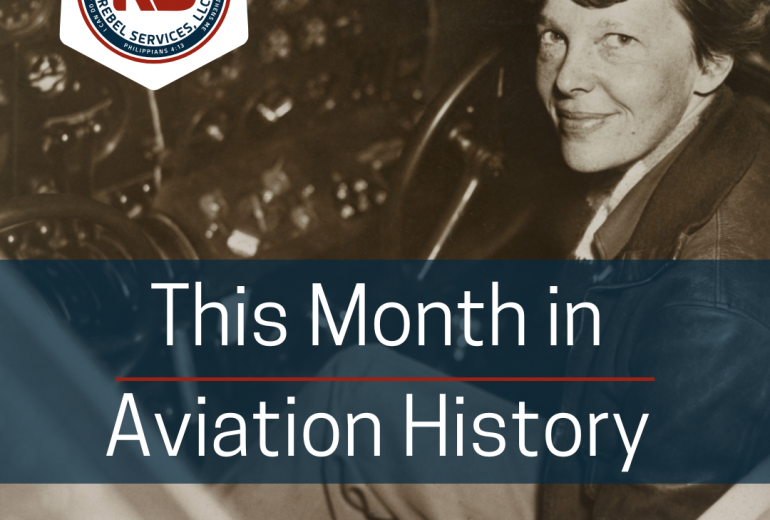This month we are kicking off a new series highlighting significant aviation events and milestones throughout history. In our first article of the series, we’re looking at all of the significant events that have happened in July since aviation began. Without further ado, let’s dive into history.
Week One
On July 1, 1931, three high school students from Struthers, Ohio claimed the first mail delivered by rocket, and in 1872, Louis Bleriot, the aviator who made the world’s first airplane fly across the English Channel, is born. On July 2, 1900, the first trial of the first Zeppelin airship, the LZ-1, is tested over Lake Constance in Germany. On the same day 19 years later, British rigid airship, R-34, becomes the first to cross over the Atlantic.
Also in 1919, on July 3rd, the first of four XB-1As made its first flight from McCook Field in Dayton, Ohio. On the same day in 1992, the longest sustained humanitarian airlift, Operation Provide Promise, began in Bosnia. During Independence Day in 1927, Lieutenant C.C. Champion, USN, establishes a new altitude level for seaplanes, reaching a height of 37,995 feet.
The first American paratrooper unit was formed on July 5, 1940. On July 6, 1919, Englishman Flt. Lt. J.E.M Pritchard became the first person to arrive in the US by air from Europe and on the same day in 1950, James Doolittle was named “Aviator of the Decade” by Harmon Aviation Awards Committee. On July 7, 1914, American physics professor, Robert H. Goddard, received a patent for his two-stage solid-fuel rocket, and in 1981, the first solar-powered aircraft makes it across the English Channel.
Week Two
Therese Peltier became the first woman to ascend in an aircraft on July 8, 1908, and on the same day in 1953, New York Airways, America's first scheduled passenger helicopter carrier, begins service. On July 9, 1910, Walter Brookins became the first to fly a mile high and was awarded $5,000 for his feat. In 1933, Charles Lindbergh and his wife began a survey flight tour of the North and South Atlantic on July 9th.
On July 10, 1938, Howard Hughes and his crewmembers began a record-breaking around-the-world flight on a specially modified Lockheed named Super Electra. On July 11, 1935, Laura Ingalls became the first woman to fly east-to-west across the United States on a flight from New York State to Burbank, CA. In 1765, the first manned balloon ascent is made in Holland on July 12 by Jean-Pierre Blanchard.
President Dwight D. Eisenhower became the first US President to fly on a helicopter on July 13, 1957. On July 14, 1937, a Soviet crew breaks the world distance flying record by staying airborne for two days while flying from Moscow over the North Pole. Three years earlier in 1934, Howard Hughes landed in New York after a record-breaking flight across the Northern Hemisphere.
Week 3
On July 15, 1916, timber merchant, William E. Boeing, formed a new aircraft company, the Pacific Aero Products Company, and in 1925, A. Hamilton Rice returned safely from the first airplane expedition to the Amazon to explore the Amazon headwaters.
Transcontinental and Western Air (TWA) formed when Transcontinental Air Transport and Western Air Express merged on July 16, 1930, and in 1971, Jeanne M. Holm, director of WAF, became the first female promoted to Brigadier General.
The first aviation legislation for the US was signed on July 17, 1908. On the same day in 1969, the Apollo 11 Saturn V was launched from Cape Canaveral en route to the first moon landing. July 19, 1937, was a sad day for aviation and the world as the search for missing flyers, Amelia Earhart and Fred Noonan was canceled.
On July 20, 1937, Colonel Lindbergh begins flying in “The Spirit of St. Louis on a tour of the country under the offices of the Guggenheim Fund. The first British airplane passenger service was launched on July 22, 1914.
Week 4
The Royal Air Force first used “Window” metal foil dropped to confuse any enemy within radar on July 24, 1943. Thirty-seven years and 24 days after his birth on July 1, 1872, Louis Bleriot makes the first airplane crossing across the English Channel on July 25, 1909. On July 26, 1947, President Truman signed the National Security Act, designating the USAF as a separate service.
On July 27, 1901, the Wright brothers begin test glides at Kill Devil Hills near Kitty Hawk, NC, on the Outer Banks Islands. On the same day 8 years later in 1909, Orville Wright made the first official test flight of the US Army’s first airplane in Fort Meyer, Virginia.
The first “jetway” in the United States was installed at the International Airport in San Francisco, California on July 29, 1959. On the 30th of July, 1924, two Japanese airmen safely returned to Osaka from the first-ever flight around Japan. And finally, on July 31, 1948, the New York International Airport opened and became the largest airport in the United States.


